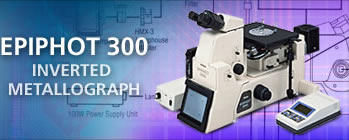Nikon Epiphot 300 Inverted Metallograph Microscopes
Nikon Updated: 2007-06-19Research-use inverted metallograph with enhanced photodocumentation capabilities.
The Epiphot 300 combines the superb CF Infinity Corrected Optical System with a matchless degree of operator comfort and rock solid stability. Add to this a full range of photomicrographic capabilities, as well as scale imprinting, and you have a cutting edge instrument providing the highest possible optical performance.
CF Infinity Corrected Optical System
An ideal optical system which combines Nikon's renowned CF Optics with Infinity Corrected design for even greater system flexibility. The result is sharp and clear images you can depend on.
2.5X Zoom from 0.8 to 2X
Changes in magnification are simultaneously applied to both observation and photomicrography. The zoom dial click-stops at 1.0x, 1.25x, 1.5x magnifications, allowing you to change magnifications without removing your eye from the sample.
Built in Photomicrographic System
Permits photomicrography in both the 35mm and 4 x 5 inch large film formats. 60% integrated average auto exposure photomicrography is possible.
Reticle Imprinting Option
Because the reticle is inserted at the primary image plane position, the micrometer maintains fine focus without being affected by the state of the sample surface being observed. Austenite reticles and grids can also be imprinted.
Operator-Friendly Design
Comfort and ease of operation were prime design considerations. The lowered stage (71mm/2.8in. lower than the previous model) and the universal joint stage handle which allows the stage to be moved by hand at a fixed position both contribute to smooth operation. The built-in interlocking aperture diaphragm which automatically adjusts during brightfield/darkfield changeover, and ergonomically located major controls within easy reach also combine to create a comfortable operating environment.
Stable and Reliable
Front and rear support of the stage, a low profile design, and a nosepiece focusing system, all make for a super stable, extremely rugged instrument.
Brightfield Observation
This is the most frequently used observation method and uses differences in reflection to obtain the natural color and shape of a sample.
Nomarski DIC Observation
This observation method can capture subtle irregularities and flaws as interference colors and indicate them in three-dimensional forms. Thanks to its ability to represent very small tilt (differential coefficient) with sharp differential contrast, this observation method can detect minute differences in height.
Darkfield Observation
This observation method is significant for observing and photomicrographing minute flaws, surface irregularities, differences in level, or samples with low reflection rates, all difficult to observe under brightfield observation.
Simple Polarization Observation
Used to analyze specific optical characteristics such as isotropy and anisotropy, this observation method permits observation with polarized contrast by way of inteference colors. Ideal for observing crystal conditions and detecting stress such as metal fatigue.
Epi-Fluorescence Observation
This observation method detects substances on a specimen in the form of fluorescent images and is effective in identifying them.
There are no manuals currently available for this model.
Related Manuals
Nikon Epiphot 200 Inverted Metallograph Microscopes
Nikon Eclipse MA100 Inverted Metallograph Microscope
Nikon Eclipse LV100D Upright Industrial Microscope
Nikon Eclipse LV150 Series Industrial Microscopes
Nikon Eclipse L300 Series FPD/LSI Inspection Microscopes
Nikon Multizoom AZ100 Multi-Purpose Microscope
Nikon COOLSCOPE Digital Microscope
Nikon Eclipse L200 Series IC Inspection Microscopes
Nikon Eclipse E100 Biological Microscope
Nikon NWL-860 IC Inspection Wafer Loader
Nikon Eclipse E200 Biological Microscope
Nikon NWL-641 IC Inspection Wafer Loader
